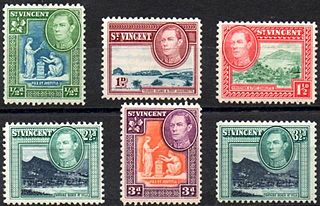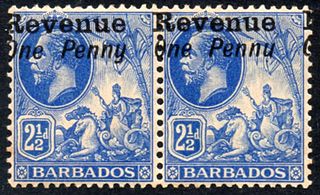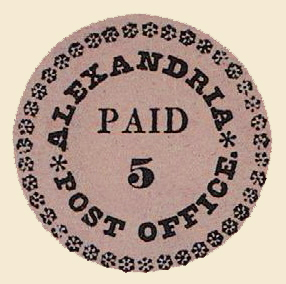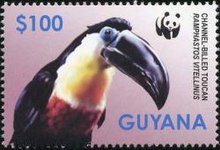
A postage stamp is a small piece of paper issued by a post office, postal administration, or other authorized vendors to customers who pay postage. Then the stamp is affixed to the face or address-side of any item of mail—an envelope or other postal cover —which they wish to send. The item is then processed by the postal system, where a postmark or cancellation mark—in modern usage indicating date and point of origin of mailing—is applied to the stamp and its left and right sides to prevent its reuse. Next the item is delivered to its addressee.

An overprint is an additional layer of text or graphics added to the face of a postage or revenue stamp, postal stationery, banknote or ticket after it has been printed. Post offices most often use overprints for internal administrative purposes such as accounting but they are also employed in public mail. Well-recognized varieties include commemorative overprints which are produced for their public appeal and command significant interest in the field of philately.

British Guiana was a British colony, part of the mainland British West Indies, which resides on the northern coast of South America. Since 1966 it has been known as the independent nation of Guyana.

Postal service in the United States began with the delivery of stampless letters whose cost was borne by the receiving person, later encompassed pre-paid letters carried by private mail carriers and provisional post offices, and culminated in a system of universal prepayment that required all letters to bear nationally issued adhesive postage stamps.

Indian postal systems for efficient military and governmental communications had developed long before the arrival of Europeans. When the Portuguese, Dutch, French, Danish and British conquered the Marathas who had already defeated the Mughals, their postal systems existed alongside those of many somewhat independent states. The British East India Company gradually annexed the other powers on the sub-continent and brought into existence a British administrative system over most of modern-day India, with a need to establish and maintain both official and commercial mail systems.
This is a partial timeline of significant events in postal history, including dates and events relating to postage stamps.

Postage stamps and postal history of Great Britain surveys postal history from the United Kingdom and the postage stamps issued by that country and its various historical territories until the present day.

A privately run packet service for mail existed in British Guiana in 1796, and continued for a number of years. Postage stamps of Britain were used in those days at Georgetown (Demerara) and Berbice. The first adhesive stamps produced by British Guiana were issued in 1850.

The British Guiana 1c magenta is regarded by many philatelists as the world's most famous rare stamp. It was issued in limited numbers in British Guiana in 1856, and only one specimen is now known to exist. It is the only major postage stamp ever issued in the United Kingdom or British Commonwealth that is not represented in Britain's Royal Philatelic Collection.

This is a survey of the postage stamps and postal history of Cuba.

The postal history of Malta began in the early modern period, when pre-adhesive mail was delivered to foreign destinations by privately owned ships for a fee. The earliest known letter from Malta, sent during the rule of the Order of St John, is dated 1532. The first formal postal service on the islands was established by the Order in 1708, with the post office being located at the Casa del Commun Tesoro in Valletta. The first postal markings on mail appeared later on in the 18th century.

The postal history of Turkey and its predecessor state, the Ottoman Empire, dates to the 18th century when foreign countries maintained courier services through their consular offices in the Empire. Although delayed in the development of its own postal service, in 1863 the Ottoman Empire became the second independent country in Asia to issue adhesive postage stamps, and in 1875, it became a founding member of the General Postal Union, soon to become the Universal Postal Union. The Ottoman Empire became the Republic of Turkey in 1923, and in the following years, its postal service became more modernized and efficient and its postage stamps expertly designed and manufactured.

This is a survey of the postage stamps and postal history of Dominica, an island nation in the Caribbean Sea. Claimed by France in the 17th century, it was later awarded to Great Britain, becoming independent in 1978.

Saint Vincent and the Grenadines, a former British colony in the Windward Islands, has produced stamps since 8 May 1861. The stamps featured either the British monarch’s head on them or the ER monogram and crown until around 1970. The stamps were printed with just "St. Vincent" until 1992 when the stamps began to print the full country name, "St. Vincent and the Grenadines".

Revenue stamps of British Guiana refer to the various revenue or fiscal stamps, whether adhesive or directly embossed, which were issued by British Guiana prior to the colony's independence as Guyana in 1966. Between the 1860s and 1890s, the colony issued Inland Revenue and Summary Jurisdiction stamps, while revenue stamps and dual-purpose postage and revenue stamps were issued during the late 19th and 20th centuries. In around the 1890s or 1900s, British Guiana possibly issued stamps for taxes on medicine and matches, but it is unclear if these were actually issued. Guyana continued to issue its own revenue stamps after independence.

The island of Barbados first issued revenue stamps in 1916. There were various types of fiscal stamps for different taxes.

The Alexandria "Blue Boy" is a rare Postmasters' Provisionals stamp produced in Alexandria, Virginia in 1847. There are seven known examples of Alexandria provisionals, however, the Blue Boy is the only specimen printed on blue paper. The other six are printed on buff paper. The Blue Boy remains affixed to its original envelope, and sold for $1.18 million in 2019, which is among the highest known prices paid for a philatelic item.

In the Act of March 3, 1845, the United States Congress standardized postal rates throughout the nation at 5¢ for a normal-weight letter transported up to 300 miles and 10¢ for a letter transported between 300 and 3,000 miles, with these rates to take effect on July 1, 1845.
Revenue stamps of Guyana refer to the various revenue or fiscal stamps, whether adhesive, directly embossed or otherwise, which have been issued by Guyana since its independence in 1966. Prior to independence, the country was known as British Guiana, and it had issued its own revenue stamps since the 19th century. Guyana used dual-purpose postage and revenue stamps until 1977, and it issued revenue-only stamps between 1975 and the 2000s. The country has also issued National Insurance stamps, labels for airport departure tax and excise stamps for cigarettes and alcohol.
















